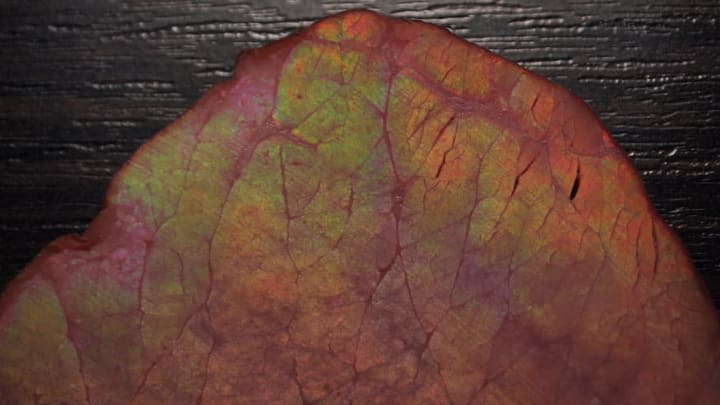We eat with our eyes first, and sometimes what we see on our plate turns us off a meal altogether. Take so-called “meat rainbows”: They happen when a slice of deli meat takes on an iridescent shimmer reminiscent of an oil puddle in a parking lot—a.k.a. not something you want on your sandwich. Despite giving a whole new meaning to the phrase "mystery meat," the odd discoloration is perfectly safe to eat, as physicist Dave McCowan at the University of Chicago explained for The Takeout.
The colorful sheen on a slice of roast beef or pastrami isn’t a sign of spoilage or chemical additives—it’s actually a result of the way the meat is cut. Slicing meat “against the grain” means cutting through, rather than parallel to, the bundles of fibers composing the meat’s musculature. This makes for a more tender bite, and it also leaves a grid of evenly-spaced meat fibers. In the right light, this surface lends itself to something called “diffraction.”
Diffraction occurs when light hits a repeating pattern of nooks and crannies. As the white light bounces off the grooves in the meat, it separates into a spectrum of distinct colors. Some of these colors are amplified, creating a mother-of-pearl appearance when viewed together. This is the same effect we see on the backs of CDs and DVDs.
Another possible culprit behind your rainbow meat is thin-film interference. This is sometimes present in meat with a thin layer of oily fat on the surface. The film affects the light passing through it in such a way that only some of the colors in the spectrum come through, hence the rainbow. This phenomenon produces a sheen closer to that of bubbles or oil slicks than laser discs.
Why do meat rainbows only seem to show up in deli slices, not raw cuts? The answer lies in the curing process. A cured ham is likely greasier than a raw pork cutlet, which makes thin-film interference more likely. The muscle fibers in cured and cooked meats are also more tightly packed together, producing the rigid grid necessary for diffraction.
Color also plays a role. Iridescent shimmers are easier to spot on darker meats like beef and some pork—so if you’re eating a slice of turkey from the deli, it could be covered in meat rainbows you don’t notice. We’ll let you decide if that’s a positive thing.
[h/t The Takeout]
